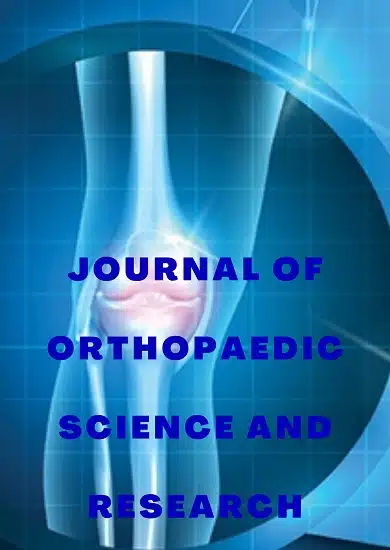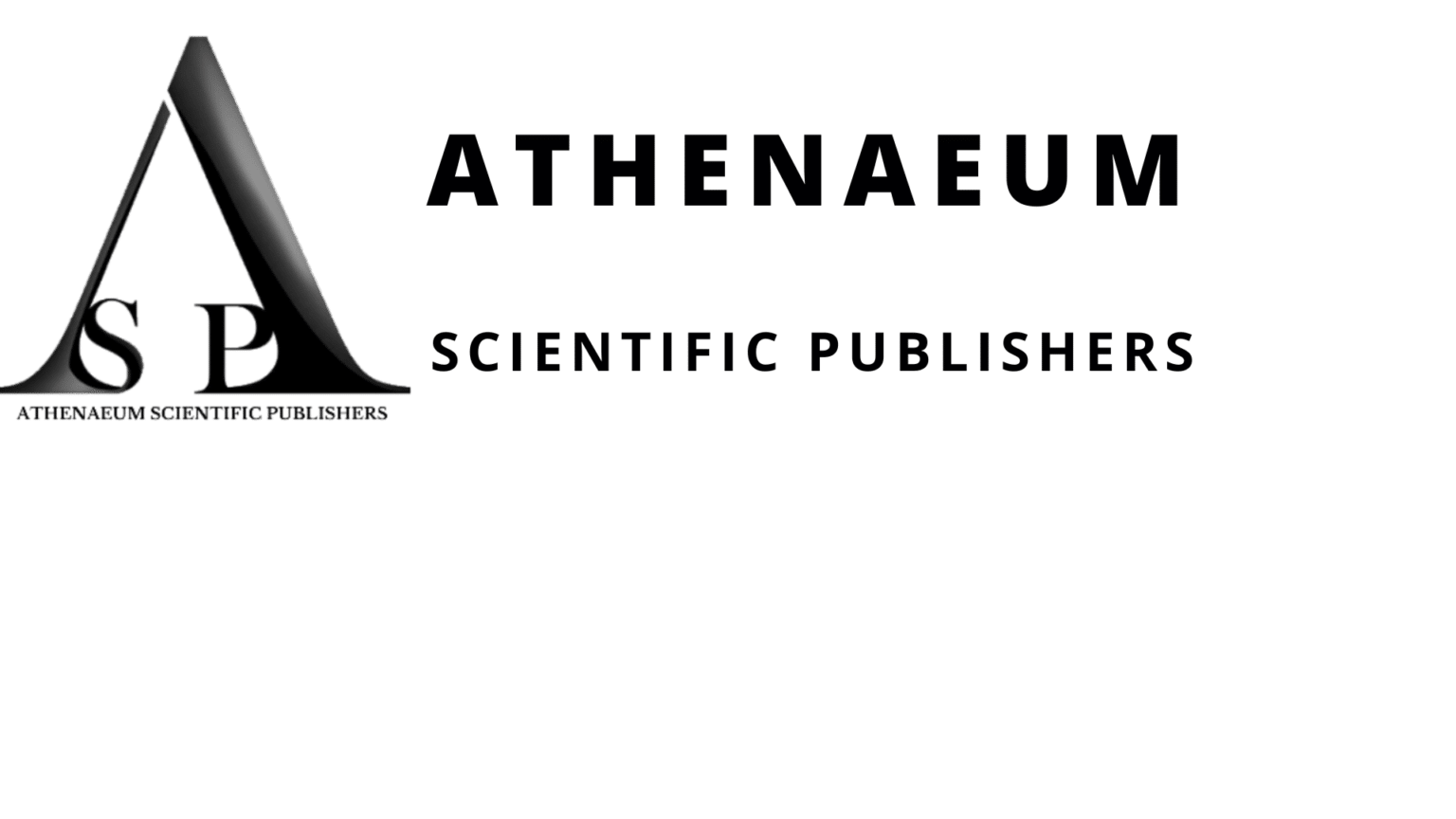Research Article | Vol. 6, Issue 2 | Journal of Orthopaedic Science and Research | Open Access |
A Retrospective Evaluation of Biologic Tuberoplasty with Medialization Technique for Massive Rotator Cuff Tears Using Acellular Dermal Matrix
Sung Hyun Yoon1, Jae-Sung Yoo1*
1Department of Orthopaedic Surgery, Dankook University College of Medicine, Cheonan, Korea
*Correspondence author: Jae-Sung Yoo, MD, Department of Orthopaedic Surgery, Dankook University College of Medicine, Cheonan, Korea; Email: [email protected]
Citation: Yoon SH, et al. A Retrospective Evaluation of Biologic Tuberoplasty with Medialization Technique for Massive Rotator Cuff Tears Using Acellular Dermal Matrix. J Ortho Sci Res. 2025;6(2):1-10.
Copyright© 2025 by Yoon SH, et al. All rights reserved. This is an open access article distributed under the terms of the Creative Commons Attribution License, which permits unrestricted use, distribution, and reproduction in any medium, provided the original author and source are credited.
| Received 22 April, 2025 | Accepted 19 May, 2025 | Published 26 May, 2025 |
Abstract
Background: Massive Irreparable Rotator Cuff Tears (MIRCTs) remain one of the most challenging conditions in shoulder surgery. While partial repair with medialization may reduce tension and biologic tuberoplasty with Acellular Dermal Matrix (ADM) can restore the tuberosity coverage, each technique alone has limitations. Combining the two may yield complementary benefits.
Purpose: To evaluate the clinical and radiologic outcomes of arthroscopic medialized partial repair combined with biologic interpositional tuberoplasty using ADM in patients with MIRCTs.
Methods: A retrospective review was conducted on 36 patients who underwent the combined procedure between 2021 and 2023, with a minimum 12-month follow-up. Clinical outcomes including the Visual Analog Scale (VAS), American Shoulder and Elbow Surgeons (ASES) score, UCLA score, Constant score and Range Of Motion (ROM) were assessed. Radiologic assessments included Acromiohumeral Distance (AHD), retear status (Sugaya classification) and graft failure. Paired t-tests were used to evaluate pre- and postoperative differences.
Results: All clinical scores showed significant improvements postoperatively: VAS (6.2 ± 1.6 to 1.5 ± 1.3, p < 0.001), ASES (35.0 ± 15.3 to 85.5 ± 14.8, p < 0.001), UCLA (21.4 ± 3.8 to 31.5 ± 2.8, p < 0.001), Constant (43.8 ± 7.2 to 86.0 ± 8.2, p < 0.001). Forward flexion, abduction and both external and internal rotation significantly improved. AHD was maintained (6.2 ± 1.5 mm to 6.4 ± 1.4 mm, p = 0.138). The retear rate based on Sugaya grade 4 or 5 was 11.1% and no graft failures were reported.
Conclusion: The combination of medialization repair and biologic tuberoplasty for MIRCTs is a viable surgical option, offering significant improvement in pain, function and ROM, while maintaining graft integrity and minimizing retear risk. This approach effectively complements the limitations of each individual technique.
Keywords: Rotator Cuff Injuries; Tissue Transplantation; Dermis; Shoulder Joint; Biomechanics; Treatment Outcome
Abbreviations
ADM: Acellular Dermal Matrix; SCR: Superior Capsule Reconstruction; MRI: Magnetic Resonance Imaging; BT: Biologic Tuberoplasty; H: Humerus; RC: Rotator Cuff
Introduction
Massive Rotator Cuff Tears (MRCTs) represent one of the most challenging conditions in shoulder surgery due to tendon retraction, muscle atrophy and poor tissue quality. These tears often result in poor healing potential and high failure rates following conventional rotator cuff repair [1,2]. While Superior Capsular Reconstruction (SCR) has emerged as a widely accepted option for treating irreparable tears, recent studies have demonstrated that SCR is not immune to retear, particularly on the humeral side, which may compromise clinical outcomes [3,4].
To overcome the limitations of SCR, biologic tuberoplasty-using a tension-free Acellular Dermal Matrix (ADM) graft as an interpositional spacer over the greater tuberosity-has gained increasing attention [5-7]. This approach aims to maintain subacromial spacing and prevent painful contact between the acromion and humeral head, even in the presence of a graft tear. In 2024, Yoo, et al., reported a retear rate of 0% using biologic tuberoplasty in the treatment of irreparable rotator cuff tears, highlighting its potential as a reliable alternative to traditional graft techniques [8].
However, not all massive tears are irreparable. In patients where repair is feasible, medialization of the rotator cuff footprint has been shown to reduce tension on the repaired tendon and improve healing rates [9]. Recognizing that biologic tuberoplasty and medialized partial repair address distinct aspects of rotator cuff pathology, combining these two techniques may yield synergistic benefits offering both tendon stability and humeral head coverage.
Therefore, the purpose of this study was to evaluate the clinical and radiologic outcomes of a combined surgical approach using medialized partial repair and biologic tuberoplasty with ADM in patients with massive but repairable rotator cuff tears. We hypothesized that this dual technique would result in improved functional outcomes, low retear rates and no graft failure at one-year follow-up.
Methodology
This retrospective study was conducted to evaluate the clinical and radiological outcomes of arthroscopic medialized partial repair combined with biologic tuberoplasty using Acellular Dermal Matrix (ADM) in patients with massive but repairable rotator cuff tears. The study protocol was approved by the Institutional Review Board (IRB) of Dankook University Medical Center and all participants provided written informed consent prior to inclusion.
Patient Selection
Between January 2021 and January 2024, a total of 53 patients with massive rotator cuff tears who underwent arthroscopic medialized partial repair combined with biologic tuberoplasty using an acellular dermal matrix were retrospectively reviewed. Massive tears were defined as full-thickness tears involving at least two tendons or with a tear size greater than 5 cm. To be included in the study, the tear had to be deemed repairable intraoperatively and the subscapularis tendon had to be intact or reparable. All patients were required to have a minimum follow-up period of 12 months.
Patients were excluded if they had an irreparable subscapularis tear, moderate to severe glenohumeral joint arthritis (Hamada grade ≥ 3), a history of prior surgery on the affected shoulder or were lost to follow-up. After applying these criteria, 17 patients were excluded-11 due to incomplete follow-up and 6 due to irreparable subscapularis involvement or advanced joint degeneration. Consequently, a total of 36 patients were included in the final analysis.
Surgical Technique
All surgeries were performed by a single surgeon with the patient in the beach-chair position under regional anesthesia. Following diagnostic arthroscopy, intra-articular pathology including subscapularis repair (if required) and biceps tenotomy or anterior cable reconstruction was addressed. Medialized partial repair was performed using 2-3 suture anchors in a single-row configuration to minimize tension on the retracted tendons (Fig. 1). Subsequently, biologic tuberoplasty was performed using a 4 mm-thick acellular dermal matrix (BellaCell®, Hans Biomed, Korea), interposed over the exposed greater tuberosity. The graft was secured using a suture-bridge technique utilizing the remaining FiberWire strands from the medial repair anchors (Fig. 1).
Postoperative Rehabilitation
All patients wore an abduction brace for 6 weeks. Pendulum exercises began at 1 week postoperatively, followed by passive range of motion exercises from 2 weeks (forward flexion ≤120°, external rotation ≤30°). Assisted active motion commenced at 6 weeks, full active motion at 8 weeks and resistive strengthening was introduced at 12 weeks. Gradual return to sports or heavy activities was allowed at 6 months postoperatively.
Clinical and Radiologic Outcomes
Clinical outcomes were assessed preoperatively and at 12 months postoperatively using validated scoring systems. These included the Visual Analog Scale (VAS) for pain, the American Shoulder and Elbow Surgeons (ASES) score, the University of California, Los Angeles (UCLA) shoulder score, the Constant score and active Range Of Motion (ROM) measurements, including forward flexion, abduction, external rotation and internal rotation. Internal rotation was recorded based on vertebral level reach in a seated position with the arm behind the back.
Radiologic evaluations were performed using plain radiographs and Magnetic Resonance Imaging (MRI) at 12 months postoperatively. The Acromiohumeral Distance (AHD) was measured on standard anteroposterior shoulder radiographs. Structural integrity of the repaired tendon was classified according to the Sugaya classification system based on T2-weighted coronal MRI images. Sugaya grades 4 and 5 were considered indicative of retear, while the presence of any discontinuity or collapse in the biologic graft was defined as graft failure (Fig 2).
All imaging studies were independently reviewed by a board-certified musculoskeletal radiologist with 17 years of experience, who was blinded to the clinical outcomes. Radiographic measurements were repeated twice at separate intervals and average values were used to improve reliability.
Statistical Analysis
A post-hoc power analysis was performed using G*Power (version 3.1.9.7, Düsseldorf, Germany). With a sample size of 36, an alpha level of 0.05 and an effect size (Cohen’s d) of 0.6-representing a moderate clinical difference in ASES scores-the achieved statistical power was calculated to be 0.81. This indicates that the study was adequately powered to detect significant differences in primary outcome measures.
All statistical analyses were performed using SPSS software (version 26.0; IBM Corp., Armonk, NY, USA). Continuous variables were presented as means and Standard Deviations (SD). The normality of the data distribution was assessed using the Shapiro-Wilk test. For comparisons between preoperative and postoperative values, paired t-tests were used for normally distributed variables and Wilcoxon signed-rank tests were applied for non-normally distributed data.
Categorical data, such as retear and graft failure rates, were presented as frequencies and percentages. Statistical significance was set at a p-value of less than 0.05. All tests were two-tailed. A post-hoc power analysis was conducted to confirm the adequacy of the sample size for detecting significant changes in ASES and VAS scores with a power of 80% and an alpha level of 0.05.

Figure 1: (A) Arthroscopic view showing medialized partial repair of the retracted rotator cuff using a single-row suture configuration; (B) Arthroscopic view after biologic tuberoplasty with a 4 mm-thick acellular dermal matrix graft secured over the greater tuberosity using a suture-bridge technique.

Figure 2: (A) Preoperative T2-weighted MRI showing a large to massive rotator cuff tear with tendon retraction; (B) Postoperative T2-weighted MRI demonstrating intact interpositional graft (Arrow) coverage over the greater tuberosity following biologic tuberoplasty.
Results
A total of 36 patients (17 males and 19 females) were included in the final analysis. The mean age at the time of surgery was 58.2 ± 6.7 years. The dominant arm was involved in 21 patients (58.3%) and the non-dominant arm in 15 patients (41.7%). The mean height and weight were 164.7 ± 8.4 cm and 63.5 ± 10.8 kg, respectively, resulting in a mean Body Mass Index (BMI) of 23.4 ± 3.1 kg/m². Among the patients, 8 (22.2%) were current or former smokers and the remaining 28 (77.8%) were non-smokers (Table 1).
Regarding anesthetic risk stratification, the American Society of Anesthesiologists (ASA) classification distribution was as follows: ASA I in 24 patients, ASA II in 10 patients and ASA III in 2 patients. The average anterior-posterior tear size measured intraoperatively was 3.8 ± 1.4 cm and the medial-lateral tear size was 3.5 ± 1.2 cm (Table 1).
Muscle quality evaluated using the Goutallier classification showed a mean grade of 3.2 (range 2-4) for the supraspinatus, 2.9 (range 2-4) for the infraspinatus, 0.4 (range 0-1) for the teres minor and 1.5 (range 0-3) for the subscapularis. The mean clinical follow-up period was 13.8 ± 1.6 months (Table 1).
All patients completed a minimum of 12 months of follow-up. Significant improvements were observed in all clinical outcome measures at 12 months postoperatively compared to baseline. VAS score decreased from 6.2 ± 1.6 to 1.5 ± 1.3 (p < 0.001) and ASES score improved from 35.0 ± 15.3 to 85.5 ± 14.8 (p < 0.001). Similarly, Constant, UCLA scores and all ROM parameters showed statistically significant improvement (all p < 0.001). Acromiohumeral distance was maintained postoperatively (6.2 ± 1.5 mm pre-op vs. 6.4 ± 1.4 mm post-op, p = 0.138, Table 2).
At 12-month postoperative MRI evaluation, 6 of the 36 patients (16.7%) showed a retear of the repaired cuff (Sugaya grade 4 or 5). However, in all 6 cases, the acellular dermal matrix used for biologic tuberoplasty remained intact and well-incorporated without evidence of graft failure. These 6 patients were analyzed as a separate subgroup and compared with the remaining 30 patients without retear (Table 2).
No statistically significant differences were observed between the retear group and the healed group in terms of postoperative VAS (1.4 ± 1.1 vs. 1.5 ± 1.4, p = 0.82), ASES score (82.3 ± 13.6 vs. 86.1 ± 14.3, p = 0.41), Constant score (84.2 ± 7.6 vs. 86.5 ± 8.4, p = 0.55) or ROM measurements. This suggests that even in the presence of cuff retear, the preserved biologic graft may contribute to pain relief and functional preservation (Fig 3).
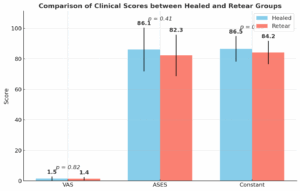
Figure 3: Comparison of clinical outcomes between the healed and retear groups. No statistically significant differences were observed in postoperative VAS, ASES and Constant scores. These findings suggest that preserved biologic grafts may contribute to pain relief and functional preservation, even in the presence of a rotator cuff retear.
Variable | Value |
Number of patients | 36 |
Mean age (years) | 58.2 ± 6.7 |
Gender (Male: Female) | 17 : 19 |
Dominant arm: Non-dominant arm | 21 : 15 |
Height (cm) | 164.7 ± 8.4 |
Weight (kg) | 63.5 ± 10.8 |
Body mass index (kg/m²) | 23.4 ± 3.1 |
Smoking: Non-smoking | 8 : 28 |
ASA class (1:2:3) | 24 : 10 : 2 |
Anterior-posterior tear size (cm) | 3.8 ± 1.4 |
Medial-lateral tear size (cm) | 3.5 ± 1.2 |
Goutallier classification – Supraspinatus | 3.2 (2–4) |
Goutallier classification – Infraspinatus | 2.9 (2–4) |
Goutallier classification – Teres minor | 0.4 (0–1) |
Goutallier classification – Subscapularis | 1.5 (0–3) |
Mean follow-up (months) | 13.8 ± 1.6 |
Table 1: Demographic data.
Outcome Measure | Preoperative (Mean ± SD) | 12-month Postoperative (Mean ± SD) | p-value |
VAS Score (Pain) | 6.2 ± 1.6 | 1.5 ± 1.3 | <0.001 |
ASES Score | 35.0 ± 15.3 | 85.5 ± 14.8 | <0.001 |
UCLA Score | 21.4 ± 3.8 | 31.5 ± 2.8 | <0.001 |
Constant Score | 43.8 ± 7.2 | 86.0 ± 8.2 | <0.001 |
Forward Flexion (°) | 135.6 ± 45.2 | 165.8 ± 20.6 | <0.001 |
Abduction (°) | 130.9 ± 40.4 | 160.6 ± 22.1 | <0.001 |
External Rotation (°) | 45 ± 12 | 52 ± 13 | <0.001 |
Internal Rotation (°) | L1 ± 2 levels | T12 ± 1 level | <0.001 |
Acromiohumeral Distance (mm) | 6.2 ± 1.5 | 6.4 ± 1.4 | 0.138 |
Retear (Sugaya Grade 4,5) | N/A | 11.1% | N/A |
Graft Failure | N/A | 0% | N/A |
Table 2: Extended clinical and radiologic outcomes.
Case Representation
Case 1
A 72-year-old female presented with a massive rotator cuff tear and underwent combined medialized repair and biologic tuberoplasty. At 12 months, MRI showed retear of the repaired tendon; however, the ADM graft remained well-incorporated. She reported a VAS score of 1, ASES score of 88, Constant score of 90 and had full active range of motion in all planes (Fig. 4).
Case 2
A 74-year-old male also demonstrated cuff retear at final follow-up, but with an intact biologic graft on MRI. Clinically, he reported no pain (VAS 0), with an ASES score of 85 and Constant score of 87. His forward flexion reached 160° and internal rotation was to L1. The patient returned to recreational golf without limitation (Fig. 5). These findings support the hypothesis that biologic tuberoplasty can serve as an effective interpositional scaffold, maintaining subacromial space and functional outcomes, even in the event of partial repair failure.
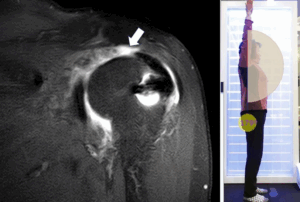
Figure 4: (A) T2-weighted coronal MRI at 12 months in a 72-year-old female patient (Case 1) showing retear of the rotator cuff tendon, while the biologic tuberoplasty graft remains intact and well-incorporated over the greater tuberosity without evidence of graft failure; (B) Clinical photograph demonstrating full active arm elevation without discomfort, indicating preserved shoulder function despite the tendon retear.
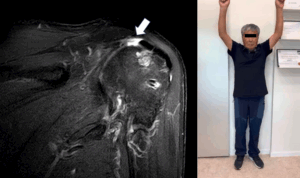
Figure 5: (A) T2-weighted MRI at final follow-up in a 74-year-old male patient (Case 2) showing retear of the rotator cuff tendon, while the biologic tuberoplasty graft remains well-incorporated without evidence of graft failure; (B) Clinical photograph demonstrating full active arm elevation, reflecting good shoulder function and pain-free status despite the tendon retear.
Discussion
In this study, none of the patients experienced graft failure and even among the six patients (16.7%) who showed retear of the repaired cuff on MRI, the biologic tuberoplasty graft remained intact and well-incorporated. Importantly, clinical outcomes-including VAS, ASES, Constant scores and ROM-did not show statistically significant differences between the retear group and the non-retear group. Notably, two representative patients who experienced retear reported no pain (VAS 0) and regained full active range of motion, suggesting that biologic tuberoplasty may serve as a functional interposition scaffold even in the event of cuff repair failure [10,11].
Massive rotator cuff tears are associated with high retear rates due to chronic degeneration, tendon retraction and fatty infiltration [12,13]. Retears can lead to persistent pain, loss of function and often require revision surgeries such as tendon transfers or reverse shoulder arthroplasty, which involve extended rehabilitation periods and can strain the physician-patient relationship [14]. To mitigate retear risk, medialized partial repair has been proposed as a tension-reducing technique. Lee, et al., reported a retear rate of 23.8% following medialization in patients with massive rotator cuff tears [15]. While medialization allows for improved tendon healing, it does not address humeral head exposure and may fail to prevent impingement between the greater tuberosity and the acromion [15,16].
Medialization is a feasible technique for cuff repair that enables tension reduction, but it can create a bare area on the greater tuberosity, potentially resulting in persistent bone-to-bone contact between the humeral head and the acromion. This anatomical exposure may contribute to residual pain even after successful tendon healing and medialization alone does not eliminate the risk of retear.
In contrast, biologic tuberoplasty provides a tension-free interpositional graft over the greater tuberosity, reducing direct bone contact and offering more freedom from graft failure. However, it has its own limitations-specifically, that no cuff repair is performed, meaning the humeral head remains uncovered and bone contact with the acromion may still occur. Furthermore, since the rotator cuff is not repaired, strength recovery must rely on indirect compensation mechanisms such as the increase in acromiohumeral distance rather than on tendon healing itself.
By combining these two techniques, the advantages of each can be maximized. Medialized repair allows for humeral head coverage and promotes tendon healing, which supports strength recovery. Simultaneously, biologic tuberoplasty contributes to pain relief and functional improvement by minimizing bone-to-bone contact and protecting the graft site from mechanical stress. Therefore, even in the presence of a cuff retear, the preservation of the graft may enable patients to achieve acceptable clinical outcomes.
Biologic tuberoplasty, on the other hand, interposes an acellular dermal matrix over the greater tuberosity in a tension-free fashion. This technique minimizes the risk of graft failure, preserves subacromial space and reduces bone-to-bone contact [17-19]. Mirzayan, et al., demonstrated that even in cases of glenoid-side graft detachment, outcomes were favorable when tuberosity coverage was maintained [18]. Similarly, Seo, et al., reported no graft failures when biologic tuberoplasty was combined with bursal acromial reconstruction, highlighting the value of mechanical spacing and cushioning between the acromion and humeral head [19]. Other studies have reinforced the role of biologic grafts as a safe, structurally stable option for restoring function without excessive tension [20,21].
Our findings are consistent with these previous studies. Although retear of the repaired tendon occurred in some patients, the absence of graft failure and the maintenance of favorable clinical outcomes suggest that biologic tuberoplasty can serve as a reliable interpositional scaffold. The “biologic tuberoplasty effect,” where an intact graft cushions the humeral head and prevents direct bone-to-bone contact, may explain the sustained outcomes even after tendon failure [18,19]. This aligns with biomechanical theories emphasizing the importance of superior capsule and subacromial integrity in preserving shoulder kinematics [22].
However, caution is warranted when interpreting the lack of statistically significant differences between the retear and non-retear groups. The relatively small number of retear cases (n=6) may introduce the possibility of a type II error-failing to detect a real difference due to insufficient power. Thus, one should not conclude that successful cuff healing is unnecessary. Repairable tendons should still be repaired to optimize long-term functional outcomes and minimize progressive degeneration [23].
This study also had specific selection criteria: patients with irreparable subscapularis tears were excluded. Furthermore, since this was a retrospective analysis, there may have been selection bias. Elderly patients with pseudoparalysis or advanced rotator cuff arthropathy were more likely to undergo reverse shoulder arthroplasty, while younger patients with significant external rotation lag often received lower trapezius tendon transfer [24], thereby excluding extremes of functional impairment from the cohort.
Several limitations must be acknowledged. First, the follow-up period of 12 months may be insufficient to assess long-term durability of tendon healing and graft function. Second, this was a retrospective study without a control group and therefore, causal relationships cannot be definitively established. Third, the sample size, particularly in the retear subgroup, limits the generalizability of the subgroup analysis. Additionally, outcomes may vary in real-world clinical settings due to variability in surgical technique, patient adherence to rehabilitation protocols and biological variability in healing response [25].
Despite these limitations, this study supports the rationale for combining medialized partial repair with biologic tuberoplasty as a complementary strategy for managing massive, but repairable, rotator cuff tears. The anatomical separation of the repair sites allows both techniques to work synergistically medial repair restores dynamic tendon force, while lateral grafting maintains subacromial space and prevents impingement even in the presence of retear.
Conclusion
In this study, combined medialized partial repair and biologic tuberoplasty demonstrated favorable pain relief and functional recovery in patients with massive, repairable rotator cuff tears. Notably, even among patients with retear of the repaired tendon, the graft remained intact and clinical outcomes were not significantly different, supporting the stability of biologic tuberoplasty. This may be attributed to the tension free nature of the graft acting as an interpositional spacer, reducing impingement between the acromion and greater tuberosity. The two techniques complement each other anatomically, providing a synergistic effect when used together. However, the small number of retear cases raises the possibility of a type II error and longer-term follow-up is warranted. Despite these limitations, this dual technique appears to be a safe and effective surgical option for managing massive rotator cuff tears that are amenable to repair.
Conflict of Interests
The authors declare no conflict of interest.
Ethics Approval and Consent to Participate
This article does not contain any studies with human participants or animals performed by any of the authors. This study was reviewed and accepted by the Dankook University medical center Institutional Review Board.
Consent for Publication
All of the authors agree to publication.
Availability of Data and Material
It is available when reviewers request.
Authorship Contribution Statement
J.S. Y. designed this study, S.H.Y took the radiologic measurements and gathered the retrospective data.
Funding/Sponsorship
There is no funding source.
References
- Burkhart SS, Danaceau SM, Pearce CE Jr. Arthroscopic rotator cuff repair: analysis of results by tear size and by repair technique-margin convergence versus direct tendon-to-bone repair. Arthroscopy. 2001;17(9):905-12.
- Gerber C, Fuchs B, Hodler J. The results of repair of massive tears of the rotator cuff. J Bone Joint Surg Am. 2000;82(4):505-15.
- Mihata T, McGarry MH, Pirolo JM, Kinoshita M, Lee TQ. Superior capsule reconstruction to restore superior stability in irreparable rotator cuff tears: a biomechanical cadaveric study. Am J Sports Med. 2012;40(10):2248-55.
- Mirzayan R, Stone MA, Batech M, Acevedo D, Singh A. Failed dermal allograft procedures for irreparable rotator cuff tears can still improve pain and function: The biologic tuberoplasty effect. Orthop J Sports Med. 2021;9(7):23259671211009332.
- Mirzayan R. Preliminary outcomes of arthroscopic biologic tuberoplasty in the treatment of massive irreparable rotator cuff tears. Cureus. 2023;15(1):e34402.
- Griffin JW, Runzo DM, Bonner KF. Tuberoplasty: Indications, technique and preliminary results. Oper Tech Sports Med. 2023;31:150979.
- Suri M, Parry S, Dham M, Verma A. Arthroscopic biologic tuberoplasty for irreparable rotator cuff tears: An expedited technique. Arthrosc Tech. 2022;11(12):e2265-70.
- Yoo JS, Jung JW, Lee JY, Seo JB. Clinical and radiologic outcomes of biologic tuberoplasty with acellular dermal matrix in irreparable massive rotator cuff tear: A single-surgeon series. J Orthop. 2024.
- Lee KW, Lee GS, Yang DS, Park SH, Chun YS, Choy WS. Clinical outcome of arthroscopic partial repair of large to massive posterosuperior rotator cuff tears: Medialization of the attachment site of the rotator cuff tendon. Clin Orthop Surg. 2020;12(3):353-63.
- Galatz LM, Ball CM, Teefey SA, Middleton WD, Yamaguchi K. The outcome and repair integrity of completely arthroscopically repaired large and massive rotator cuff tears. J Bone Joint Surg Am. 2004;86(2):219-24.
- Denard PJ, Brady PC, Adams CR, Tokish JM, Burkhart SS. Preliminary results of arthroscopic superior capsule reconstruction with dermal allograft. Arthroscopy. 2018;34(1):93-9.
- Mirzayan R, Bouz G. Biologic tuberoplasty with an acellular dermal allograft for massive rotator cuff tears. Arthrosc Tech. 2021;10(7):e1743-9.
- Seo JB, Jung JW, Yoo JS. Combination of arthroscopic biologic tuberoplasty and bursal acromial reconstruction. J Orthop. 2024;51:1-6.
- Elhassan BT, Wagner ER, Werthel JD. Outcome of lower trapezius transfer to reconstruct massive irreparable posterior-superior rotator cuff tear. J Shoulder Elbow Surg. 2016;25(8):1346-53.
- Davies A, Singh P, Reilly P, Sabharwal S, Malhas A. Superior capsule reconstruction, partial cuff repair, graft interposition, arthroscopic debridement or balloon spacers for large and massive irreparable rotator cuff tears: A systematic review and meta-analysis. J Orthop Surg Res. 2022;17(1):552.
- Jeong JH, Yoon EJ, Kim BS, Ji JH. Biceps-incorporating rotator cuff repair with footprint medialization in large-to-massive rotator cuff tears. Knee Surg Sports Traumatol Arthrosc. 2022;30(6):2113-22.
- Yoo JC, Ahn JH, Koh KH, Lim KS. Rotator cuff integrity after arthroscopic repair for large tears with less-than-optimal footprint coverage. Arthroscopy. 2009;25(10):1093-100.
- Mihata T, Bui CNH, Akeda M. A biomechanical cadaveric study comparing superior capsule reconstruction using fascia lata allograft with human dermal allograft for irreparable rotator cuff tear. J Shoulder Elbow Surg. 2017;26(12):2158-66.
- Burkhart SS, Esch JC, Jolson RS. The rotator crescent and rotator cable: An anatomic description of the shoulder’s “suspension bridge”. Arthroscopy. 1993;9(6):611-6.
- Kim HM, Dahiya N, Teefey SA, Keener JD, Galatz LM, Yamaguchi K. Relationship of tear size and location to fatty degeneration of the rotator cuff. J Bone Joint Surg Am. 2010;92(4):829-39.
- Namdari S, Donegan RP, Dahiya N, Galatz LM, Yamaguchi K, Keener JD. Characteristics of small to medium-sized rotator cuff tears with and without disruption of the anterior supraspinatus tendon. J Shoulder Elbow Surg. 2014;23(1):20-7.
- Shin SJ, Lee S, Hwang JY, Lee W, Koh KH. Superior capsular reconstruction using acellular dermal allograft combined with remaining rotator cuff augmentation improved shoulder pain and function at 1 year after the surgery. Arthroscopy. 2022;38(4):1089-98.
- Park SR, Sun DH, Kim J, Lee HJ, Kim JB, Kim YS. Is augmentation with the long head of the biceps tendon helpful in arthroscopic treatment of irreparable rotator cuff tears? J Shoulder Elbow Surg. 2018;27(11):1969-77.
- Adams CR, DeMartino AM, Rego G, Denard PJ, Burkhart SS. The rotator cuff and the superior capsule: Why we need both. Arthroscopy. 2016;32(12):2628-37.
- Jordan RW, Sharma N, Daggett M, Saithna A. The role of Superior Capsule Reconstruction in the irreparable rotator cuff tear: A systematic review. Orthop Traumatol Surg Res. 2019;105(8):1535-42.
Author Info
Sung Hyun Yoon1, Jae-Sung Yoo1*
1Department of Orthopaedic Surgery, Dankook University College of Medicine, Cheonan, Korea
*Correspondence author: Jae-Sung Yoo, MD, Department of Orthopaedic Surgery, Dankook University College of Medicine, Cheonan, Korea;
Email: [email protected]
Copyright
Sung Hyun Yoon1, Jae-Sung Yoo1*
1Department of Orthopaedic Surgery, Dankook University College of Medicine, Cheonan, Korea
*Correspondence author: Jae-Sung Yoo, MD, Department of Orthopaedic Surgery, Dankook University College of Medicine, Cheonan, Korea;
Email: [email protected]
Copyright© 2025 by Yoon SH, et al. All rights reserved. This is an open access article distributed under the terms of the Creative Commons Attribution License, which permits unrestricted use, distribution, and reproduction in any medium, provided the original author and source are credited.
Citation
Citation: Yoon SH, et al. A Retrospective Evaluation of Biologic Tuberoplasty with Medialization Technique for Massive Rotator Cuff Tears Using Acellular Dermal Matrix. J Ortho Sci Res. 2025;6(2):1-10.

